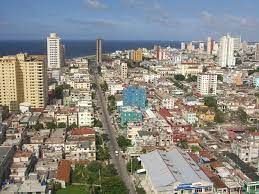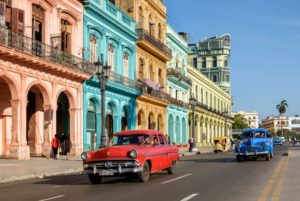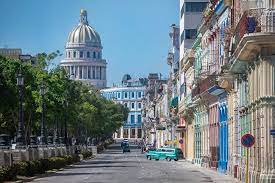LA HABANA, CAPITAL Y PATRIMONIO DE LA REPUBLICA DE CUBA. PHOTOS.
La Habana es la capital de Cuba, su urbe más grande, el principal puerto, su centro económico-cultural y su principal polo turístico. Es la ciudad más poblada del país con una población de 2,129,561 habitantes en 2021,24 y la más poblada de la región del Caribe. Como capital de Cuba, la ciudad es la sede oficial de los órganos superiores del Estado y el Gobierno cubano, de todos los organismos centrales y de casi la totalidad de empresas y asociaciones de ámbito nacional. Además, reúne la mayor cantidad de sucursales y casas matrices de las entidades extranjeras radicadas en Cuba.
PATRIMONIO DE CAPITAL CUBANA…
– Fortaleza de San Carlos de la Cabaña: Es una fortaleza situada al este de la bahía. La Cabaña es la fortaleza más grande construida por España en América. Esta fue construida a partir de la invasión inglesa y finalizada a finales del siglo xviii. En la actualidad, es la sede principal de la Feria Internacional del Libro y de la Bienal de La Habana, entre otros eventos.
– Capitolio Nacional: Fue construido en 1929 para alojar el Senado y la Cámara de Representantes. Este edificio colosal es visible desde casi toda la ciudad con su cúpula imponente de color dorado después de la última restauración. Tres grandes estatuas se encuentran en esta edificación: las dos primeras se encuentran en lo alto de la escalinata, “La Virtud” y “El Trabajo” y en su interior está la “Estatua de la República”, representada por la diosa griega Palas Atenea, tercera estatua más grande en el mundo bajo techo. Los grandes pasillos llamados “Salón de los Pasos Perdidos”, llevan a los hemiciclos norte y sur, antiguos lugares de sesiones del antiguo Congreso; aunque se desconoce si en las próximas legislaturas el parlamento cubano sesionará en el Hemiciclo Norte. Después del Triunfo de la Revolución el Capitolio fue la sede de la Academia de Ciencias y del Ministerio de Ciencias Tecnología y Medio ambiente. Posterior a la restauración capital a la que fue sometido retomó su función original y en estos momentos es la sede institucional de la Asamblea Nacional del Poder Popular y del Consejo de Estado.
– Cementerio de Colón: Cementerio y museo a cielo abierto. Es el más famoso y grande cementerio en toda América, conocido por su belleza y la magnificencia de sus esculturas. Considerado como tercero de importancia mundial, precedido solamente por el de Staglieno en Génova, Italia y el de Montjuïc en Barcelona, España.
– La Calle 23 en El Vedado: Una de las arterias principales de la ciudad, desemboca en El Malecón, en ella se encuentran desde la sede de varios ministerios como el de Salud Pública o el de Trabajo, hasta la famosa heladería Coppélia, a la que los habaneros llaman ‘La catedral del helado’, pasando por los exclusivos hoteles, clubes y discotecas, a los que acuden cientos de jóvenes los fines de semana.
– Calle Obispo: Es una de las calles más famosas y transitadas de La Habana. Las tiendas se suceden una tras otra, con numerosas boutiques de marcas como Adidas, VÍA UNO, Mango, Óscar de la Renta, etc., cuyas ventas se realizan únicamente en pesos convertibles (CUC). También se pueden encontrar restaurantes, ventas de artesanía, librerías, museos, antiguas farmacias. La bella arquitectura de las casas y edificios circundantes la convierten en uno de los sitios más imprescindible de la ciudad. Es el Bulevar más largo de La Habana y se encuentra en el municipio de la Habana Vieja.
– Isla del Coco: Aunque inicialmente era conocido como Coney Island, fue uno de los primeros parques temáticos de Cuba y de América Latina, inspirado en el mítico parque neoyorquino en la isla de Coney, es hoy después de una fuerte reparación, centro de atracción en la ciudad, con numerosos aparatos electrónicos y juegos, además de cafeterías y restaurantes. Está ubicado al oeste, en el barrio de Miramar.
– Iglesia de Reina: Dedicada al Sagrado Corazón, es la iglesia más alta de Cuba, y una de las más fastuosas, es de un estilo neogótico, con numerosas gárgolas y torres. Frecuentemente visitada por turistas.
– Catedral Ortodoxa: Concebida por el arquitecto ruso Alexey Vorontsov, se trata de una edificación monumental bizantina, finalizada en 2008, que abarca un área de 1200 metros cuadrados. En la planta baja del templo están ubicados las áreas administrativas, las habitaciones del padre, el baño público, la cocina, un salón de reuniones y una sala de computación. En la parte superior está la iglesia, con capacidad para quinientas personas, que pueden acceder mediante dos escaleras de granito.
– Ciudad Deportiva: En uno de los sitios más conocidos de la ciudad de La Habana, la intersección de las avenidas Boyeros y Vía Blanca, se presenta a la vista de todos los transeúntes una instalación muy especial, la Ciudad Deportiva, que en su majestuoso coliseo, una de las obras de mayor relevancia de la Ingeniería Civil cubana, ha albergado durante casi cinco décadas a un sinnúmero de eventos deportivos, políticos, educativos y culturales.Posee además estadios y un complejo de piscinas.
– La Fuente Luminosa: Está bordeada por una amplia rotonda donde confluyen la calle 26, la Vía Blanca y la Avenida de Rancho Boyeros, principal enlace con el aeropuerto internacional José Martí. Formó parte de un programa urbanístico que llevó a cabo el denominado «Gobierno Auténtico» del presidente Ramón Grau San Martín, a mediados de la década de 1940.
– El Parque Central: Es uno de los sitios más conocidos y céntricos de la ciudad de La Habana. Su construcción fue terminada en el año 1877 luego de que fueron derribadas las murallas que rodeaban la ciudad. Se encuentra ubicado entre las calles Prado, Neptuno, Zulueta y San José, y el bulevar de San Rafael termina frente a este.
– Plaza Vieja: Se le llamó originalmente Plaza Nueva. Surgió como espacio abierto en 1559, luego de la plaza de Armas y la de San Francisco, respectivamente, aunque hay algunos autores que señalan que fue la segunda plaza existente en La Habana. Fue zona residencial de la plutocracia criolla en tiempos de la colonia. El conjunto arquitectónico urbanístico de la Plaza Vieja está representado por valiosas construcciones coloniales de los siglos xvii, xviii y xix y algunos ejemplos de las primeras décadas del siglo xx que mantienen unidad estilística.
– Plaza de Armas: Es la plaza más antigua de las 4 plazas principales del casco antiguo de La Habana. En ella encontrarás varias edificaciones históricas y museos, entre los que destaca el Castillo de la Real Fuerza.
Catedral de San Cristóbal de La Habana: Es una de las construcciones religiosas más bonitas del barroco americano. Se encuentra emplazada en la plaza de la Catedral, otra de las principales plazas de la ciudad, rodeada de palacios históricos.
– Palacio de la Revolución: El Palacio de la Revolución es el principal edificio dentro del Complejo plaza de la Revolución (Anteriormente Plaza Cívica) ubicado en la capital cubana. En él se encuentran las sedes de la Presidencia de la República, el Consejo de Ministros y del Comité Central del PCC. Originalmente fue concebido como Palacio de Justicia y Tribunal Supremo. En 1965 el gobierno revolucionario Castro-Dórticos, ordenó trasladar hacia aquí la sede del gobierno y del estado que anteriormente radicaba en el Palacio Presidencial (actual Museo de la Revolución). El edificio está dividido en tres partes, en la primera radican las oficinas del primer ministro y del Consejo de Ministros, en la segunda la sede de la Presidencia y Vicepresidencia de la República y en el tercero del Comité Central del PCC.
HAVANA, CAPITAL, AND HERITAGE OF THE REPUBLIC OF CUBA. PHOTOS.
Havana is the capital of Cuba, its largest city, its main port, its economic-cultural center, and its main tourist destination. It is the most populous city in the country with a population of 2,129,561 inhabitants in 2021,24 and the most populous in the Caribbean region. As the capital of Cuba, the city is the official headquarters of the highest organs of the Cuban State and Government, of all the central organisms, and of almost all the companies and associations at the national level. In addition, it brings together the largest number of branches and headquarters of foreign entities based in Cuba.
CUBAN CAPITAL HERITAGE…
– San Carlos de la Cabaña Fortress: It is a fortress located to the east of the bay. La Cabaña is the largest fortress built by Spain in America. This was built after the English invasion and finished at the end of the 18th century. Currently, it is the main venue for the International Book Fair and the Havana Biennial, among other events.
– National Capitol: It was built in 1929 to house the Senate and the House of Representatives. This colossal building is visible from most of the city with its towering gold-colored dome after the latest restoration. Three large statues are found in this building: the first two are at the top of the stairs, “La Virtud” and “El Trabajo” and inside is the “Statue of the Republic”, represented by the Greek goddess Pallas Athena, third largest statue in the world under roof. The great corridors called “Salón de Los Pasos Perdidos”, lead to the north and south hemicycles, former places of sessions of the old Congress; although it is unknown if in the next legislatures the Cuban parliament will meet in the Northern Hemicycle. After the Triumph of the Revolution, the Capitol was the headquarters of the Academy of Sciences and the Ministry of Science, Technology, and the Environment. After the capital restoration to which it was subjected, it resumed its original function and is currently the institutional headquarters of the National Assembly of People’s Power and the Council of State.
– Colón Cemetery: Cemetery and an open-air museum. It is the most famous and largest cemetery in all of America, known for its beauty and the magnificence of its sculptures. Considered the third largest in the world, preceded only by Staglieno in Genoa, Italy, and Montjuïc in Barcelona, Spain.
– Calle 23 in El Vedado: One of the main arteries of the city, it ends at El Malecón, where you can find the headquarters of several ministries such as Public Health or Labor, to the famous Coppélia ice cream parlor, to the Havanans call ‘The Cathedral of Ice Cream’, passing through the exclusive hotels, clubs, and discos, to which hundreds of young people go on weekends.
– Obispo Street: It is one of the most famous and busy streets of Havana. The stores follow one another, with numerous boutiques of brands such as Adidas, VÍA UNO, Mango, Óscar de la Renta, etc., whose sales are made only in convertible pesos (CUC). You can also find restaurants, craft sales, bookstores, museums, and old pharmacies. The beautiful architecture of the surrounding houses and buildings makes it one of the most essential places in the city. It is the longest boulevard in Havana and is located in the municipality of Old Havana.
– Isla del Coco: Although it was initially known as Coney Island, it was one of the first theme parks in Cuba and Latin America, inspired by the mythical New York park on Coney Island. Today, after extensive repairs, it is a center of attraction. in the city, with numerous electronic gadgets and games, as well as cafes and restaurants. It is located to the west, in the Miramar neighborhood.
– Iglesia de Reina: Dedicated to the Sacred Heart, it is the tallest church in Cuba, and one of the most lavish, it is in a neo-Gothic style, with numerous gargoyles and towers. Frequently visited by tourists.
– Orthodox Cathedral: Conceived by the Russian architect Alexey Vorontsov, it is a monumental Byzantine building, completed in 2008, which covers an area of 1,200 square meters. On the ground floor of the temple are located the administrative areas, the father’s rooms, the public bathroom, the kitchen, a meeting room, and a computer room. At the top is the church, with a capacity of five hundred people, which can be accessed by two granite stairs.
– Sports City: In one of the best-known places in the city of Havana, the intersection of Boyeros and Vía Blanca avenues, a very special installation is presented to all passersby, the Sports City, which in its majestic Coliseum, one of the most important works of Cuban Civil Engineering, has hosted countless sporting, political, educational and cultural events for almost five decades. It also has stadiums and a swimming pool complex.
– La Fuente Luminosa: It is bordered by a wide roundabout where Calle 26, Vía Blanca and Avenida de Rancho Boyeros converge, the main link to the José Martí International Airport. It was part of an urban program carried out by the so-called “Authentic Government” of President Ramón Grau San Martín, in the mid-1940s.
– Central Park: It is one of the most well-known and central places in the city of Havana. Its construction was completed in 1877 after the walls that surrounded the city was demolished. It is located between Prado, Neptuno, Zulueta, and San José streets, and San Rafael Boulevard ends in front of it.
– Plaza Vieja: It was originally called Plaza Nueva. It emerged as an open space in 1559, after the Plaza de Armas and San Francisco, respectively, although there are some authors who point out that it was the second existing plaza in Havana. It was a residential area of the Creole plutocracy in colonial times. The urban architectural ensemble of the Plaza Vieja is represented by valuable colonial constructions from the 17th, 18th, and 19th centuries and some examples from the first decades of the 20th century that maintain stylistic unity.
– Plaza de Armas: It is the oldest square of the 4 main squares of the old town of Havana. In it, you will find several historical buildings and museums, among which the Castillo de la Real Fuerza stands out.
Cathedral of San Cristóbal de La Habana: It is one of the most beautiful religious buildings of the American baroque. It is located in the Plaza de la Catedral, another of the main squares in the city, surrounded by historic palaces.
– Palace of the Revolution: The Palace of the Revolution is the main building within the Plaza de la Revolución Complex (formerly Plaza Cívica) located in the Cuban capital. In it are the headquarters of the Presidency of the Republic, the Council of Ministers, and the Central Committee of the PCC. It was originally conceived as a Palace of Justice and Supreme Court. In 1965, the revolutionary government Castro-Dórticos ordered the seat of government and state to be moved here, which was previously located in the Presidential Palace (now the Museum of the Revolution). The building is divided into three parts, in the first are the offices of the Prime Minister and the Council of Ministers, in the second the headquarters of the Presidency and Vice Presidency of the Republic and in the third the Central Committee of the PCC.
Agencies/ Wiki/ LaHabanaHist./ Extractos/ Excerpts/ Internet Photos/ Arnoldo Varona/ www.TheCubanHistory.com
THE CUBAN HISTORY, HOLLYWOOD.



 LA HABANA, Capital y Patrimonio de la República de Cuba. PHOTOS. * HAVANA, Capital, and Heritage of the Republic of Cuba. PHOTOS.
LA HABANA, Capital y Patrimonio de la República de Cuba. PHOTOS. * HAVANA, Capital, and Heritage of the Republic of Cuba. PHOTOS.







